With proper care and adherence to planting schedules, any apricot tree rewards gardeners with a rich and delicious harvest. To choose the right variety, it's recommended to study its characteristics: care requirements, ripening period, disease resistance, and yield. Some apricots only bear fruit under long and hot summer conditions, while others thrive even in regions with frost and strong winds. Below, we describe the best dessert and table apricot varieties.
Table of contents
Early-Ripening Apricot Varieties

Early apricot trees bear fruit as early as the beginning of summer — fruiting starts around June 25 and ends by July 5. The early harvest is enjoyed fresh or sent for processing. Most table varieties are not suitable for long-term storage.
Early Melitopol

The self-pollinating, high-yielding Early Melitopol apricot bears fruit in its fifth year after planting. The fruit weighs around 40 g and has a rounded shape. The skin is dense, bright orange with a reddish blush on one side, and velvety in texture. The pit is centrally located and separates easily from the flesh. This variety is frost-resistant — it can withstand temperatures as low as -30°C.
Harostar
This mid-early variety is grown in regions with short, cool summers — such as Northern Europe and mountainous areas. The fruits weigh 50–70 g, with a smooth, rounded surface and an orange-yellow hue with red undertones. The flesh is moderately dense, and Harostar is versatile in use. For optimal yield, it's recommended to enrich the soil with a phosphorus-based fertiliser.

Early Bryansk
According to experienced gardeners, the early-ripening Early Bryansk apricot adapts well to various European climates. The tree is medium-sized, and the fruits are small, weighing about 25 g. The skin is yellow and firm — making the harvest suitable for transport and storage. This self-fertile variety is disease-resistant, with a harmonious, sweet flavour.
Goldrich
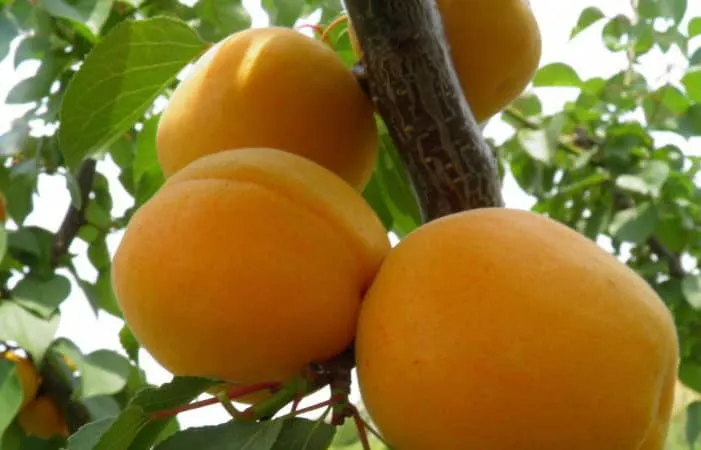
A winter-hardy and early-fruiting variety — the tree bears fruit in its second year. The apricots are exceptionally large and appetising — weighing up to 100 g, sometimes even 150 g. The colour is orange with a faint blush. The taste is sweet-tart, with a pronounced fruity aroma. The pit is medium-sized. Goldrich apricots can be stored for up to two weeks in wooden crates lined with newspaper, ideally in a cool, dark cellar.
Early Kiev
The high-yielding Early Kiev apricot is low-maintenance and begins fruiting in its third year. It is winter-hardy, tolerating temperatures down to -25°C. The fruit weighs around 80 g, with an elongated oval shape. The skin is firm and velvety, with an attractive orange blush, and the fruit can be stored for up to three weeks. The elongated pit separates easily from the juicy, sweet flesh. Early Kiev is resistant to rot and powdery mildew.
Did you know? Many people confuse fresh apricots, dried apricots, and whole dried apricots with pits. The latter refers to sun-dried apricots with the pit intact, while fresh apricots are picked straight from the tree, and dried apricots are pitted before drying.
Mid-Season Apricot Varieties
Mid-season varieties finish fruiting around late July. They are known for their large size and juicy flesh. The trees are low-maintenance, and the fruit stays firmly on the branches after ripening. The exact harvest time depends on the variety, growing region, and care practices.
Dessertny
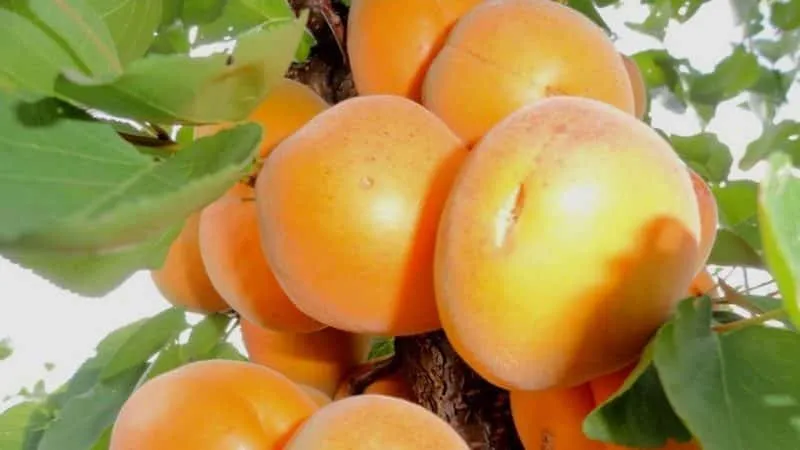
This mid-season variety ripens by mid-July. The fruits are medium-sized, weighing about 30 g. The skin is thin and pale yellow. The flesh is tender and juicy, with a sweet-tart flavour. The large pit separates easily. Dessertny is grown in Central Europe and is excellent for culinary uses — adding to ice cream, making fruit cocktails, or baking cakes and cheesecakes.
Ulyanikhinsky
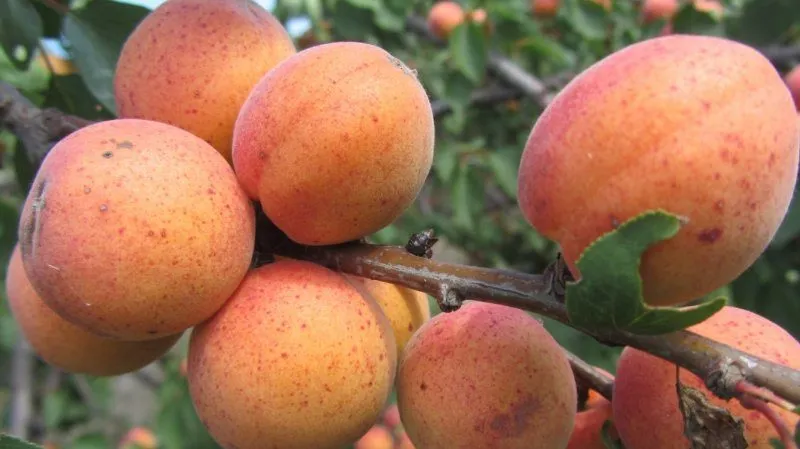
The Ulyanikhinsky apricot ripens in late July. The fruits are oval-round, weighing 30–50 g. The colour is bright yellow with slight fuzz. The flesh is pleasantly sweet-tart. This winter-hardy and disease-resistant variety is popular in temperate climates. It is ideal for making jams and compotes. While low-maintenance, it benefits from regular organic and mineral fertilisation.
Aquarius
The fruits are oval-round, yellow-orange with slight fuzz. The flesh is tender and sweet-tart. Each apricot weighs about 25 g, with some reaching 40 g. Aquarius begins fruiting in its third year. It is pest-resistant and requires minimal care, though winter protection and spring pruning are recommended to maintain productivity.
Royal
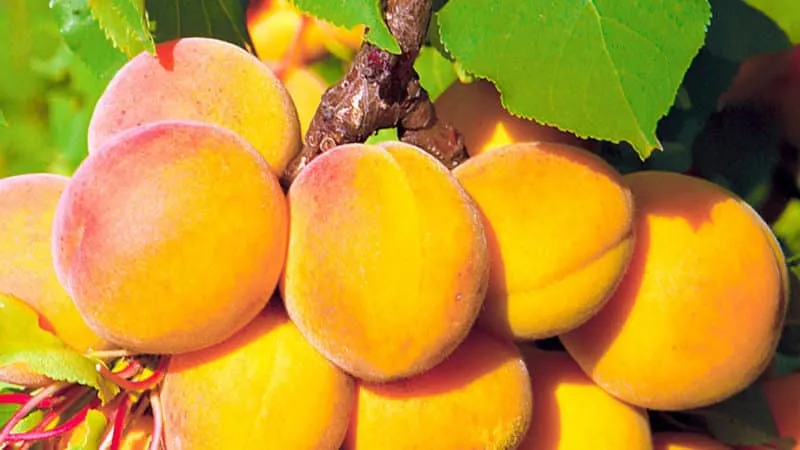
The Royal apricot thrives in nutrient-rich, well-watered soil. The tree grows up to 3 m tall. This self-fertile variety is rarely diseased. The flesh is tender with a slight tartness. The apricots are yellow with a pink blush and slight fuzz, weighing up to 35 g, with a slightly flattened round shape. Fruiting begins in the fourth year.
Big Red
Big Red apricots stand out for their appealing commercial qualities — the yellow-red fruits look enticing both on the tree and after harvest. Each apricot weighs up to 100 g, with honey-sweet flesh and firm skin. Big Red is frost-resistant, tolerating temperatures as low as -30°C. The tree bears fruit in its third year and is rarely affected by diseases. The thick skin prevents cracking.
Olympus
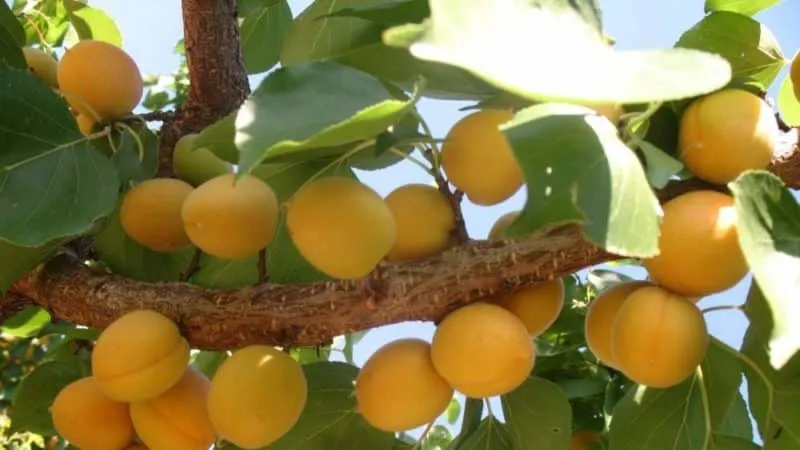
The Olympus apricot requires ample space — the tree is tall and spreading. The fruits are oval-egg-shaped, dark orange, and weigh 40–70 g. The flesh is firm and sweet. Fruiting begins in the fourth year, with harvest around mid-July. Olympus is frost-resistant, resistant to aphids and powdery mildew, and rarely affected by viral diseases.
Phelps
A medium-sized tree with a rounded crown. The apricots weigh 70–100 g, with a yellow-red blush and broad oval shape. The aromatic flesh has a balanced sweet-tart flavour. Phelps ripens in early July, fruiting in its fourth or fifth year. It is pest-resistant and disease-tolerant, with fruits that remain intact after ripening.
Did you know? Among popular mid-season varieties are apricots from American breeding programs. The Superior apricot ripens in mid-July, with 60 g oval-egg-shaped fruits. It has an attractive light-orange hue with a blush and pink speckles. Another well-known variety, Juicy Honey, stands out for its exceptionally sweet, juicy flesh with a honeyed aroma.
Best Late-Season Apricot Varieties
Late-season apricots are grown not only in private gardens but also on farms. The harvest is ideal for storage and sale — these varieties are known for their long shelf life and transportability. Late varieties bloom in late July, with fruit picking in August.
Hargrand
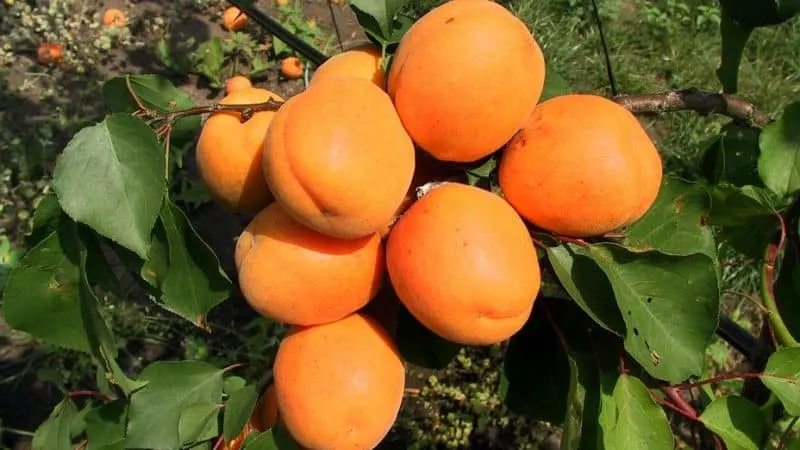
This late Canadian variety ripens in mid-July. The tree is medium-sized, with dense foliage and elongated leaves. The fruits are large, weighing up to 70 g, with an oval-round shape and orange-pink blush. The honey-sweet flesh is high in sugar. Hargrand apricots are perfect fresh — a refreshing treat on a hot day.
Favourite
A moderately vigorous tree, reaching up to 4 m in height. The fruits weigh 30 g, with a ribbed oval-round shape. The firm, slightly crunchy flesh scores 5/5 for taste. Favourite begins fruiting in its fourth or fifth year. This drought- and frost-resistant variety is excellent for fresh eating, jams, and preserves.
Orlovchanin
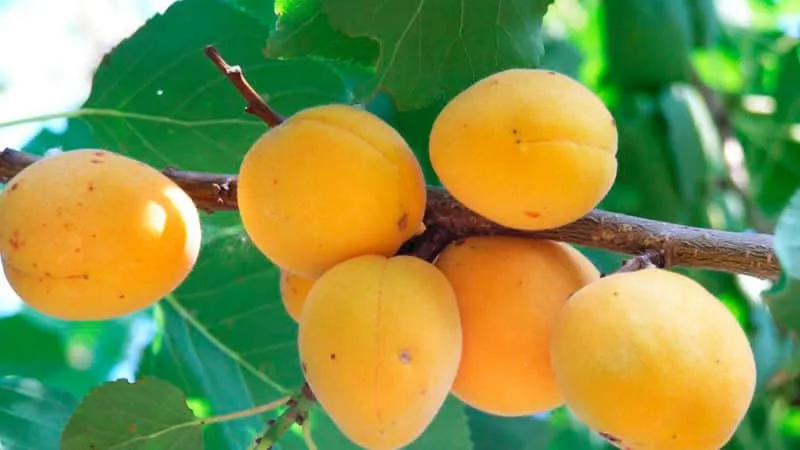
The fast-fruiting Orlovchanin yields its first harvest in its third year. It resists viral and fungal diseases and is rarely bothered by pests. The fruits weigh 30 g, with a yellow-speckled oval-egg shape. The small pit separates easily, making this variety ideal for transport and storage.
Sardonyx
This frost-resistant variety ripens by early August. Sardonyx is partially self-fertile, so growers plant other apricot trees nearby for cross-pollination. The apricots weigh 40–50 g, with tender, sugary flesh and a firm texture. The deep orange skin is thick. Sardonyx is low-maintenance, best planted in spring. It thrives in Central and Southern Europe.
Small-Fruited Apricot Varieties
Small apricots are perfect for preserves — their petite size looks delightful in jars. They are also great for sale and transport. These fruits weigh 15–20 g, with moderately sweet flesh and firm skin.
Snezhinsky
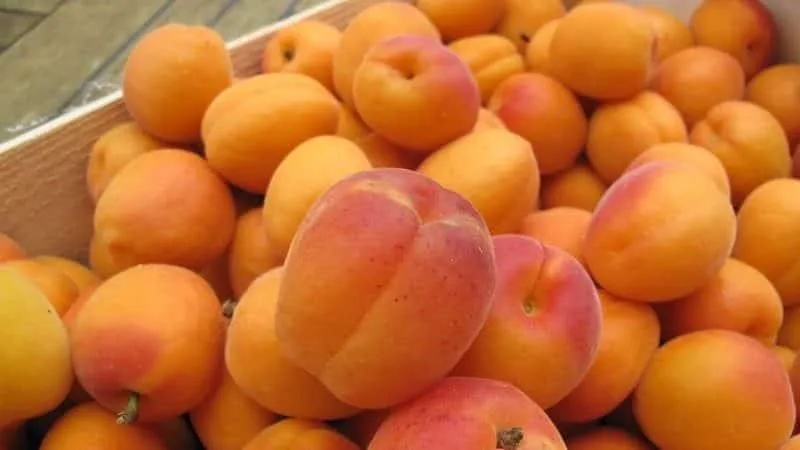
A medium-sized tree with a spreading crown. The apricots weigh 21 g, with yellow skin and dark red speckles. The skin is firm and slightly fuzzy. The pale orange flesh is soft, juicy, and sweet, scoring 5/5 for commercial quality. The round pit separates easily. Snezhinsky is enjoyed fresh or used in baking, desserts, and drinks.
Iceberg
The tree grows up to 3 m tall, with a moderately spreading crown. The small fruits weigh 18–22 g. The thin, yellow-orange skin has slight fuzz. The yellow flesh is dessert-sweet, rated 4/5. Iceberg’s advantages include long shelf life, versatility, and frost resistance. Harvest occurs in late July to early August.
Success
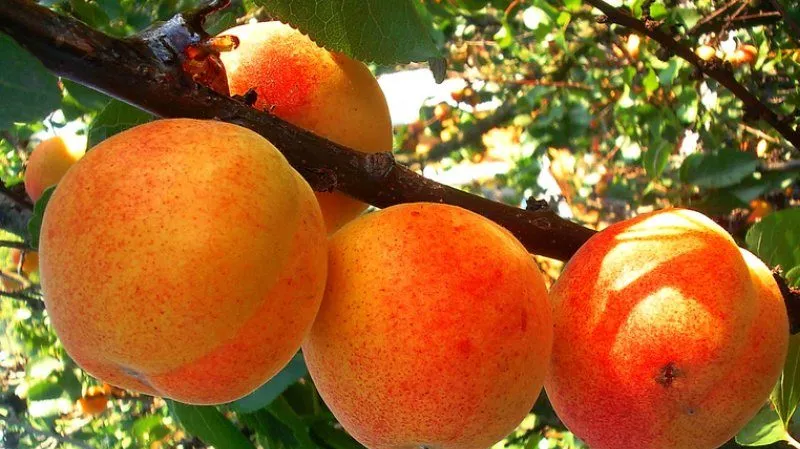
A medium-sized tree with a pyramidal-rounded crown. Success ripens in late August, or early September in cooler regions. The fruits weigh 23 g, with a round shape and thin skin. The yellow-amber hue shimmers beautifully in sunlight. The fibrous flesh has a balanced sweet-tart flavour. Success is fast-fruiting, yielding harvests in its fourth or fifth year.
Amur
The average weight of an Amur apricot is 20–22 g, with an oval-round shape. The vibrant yellow skin has carmine speckles. The moderately juicy flesh is sweet. These apricots are used for processing and grown commercially. Amur begins fruiting in its third year, ripening between August 10–20, depending on climate and weather.
Edelweiss
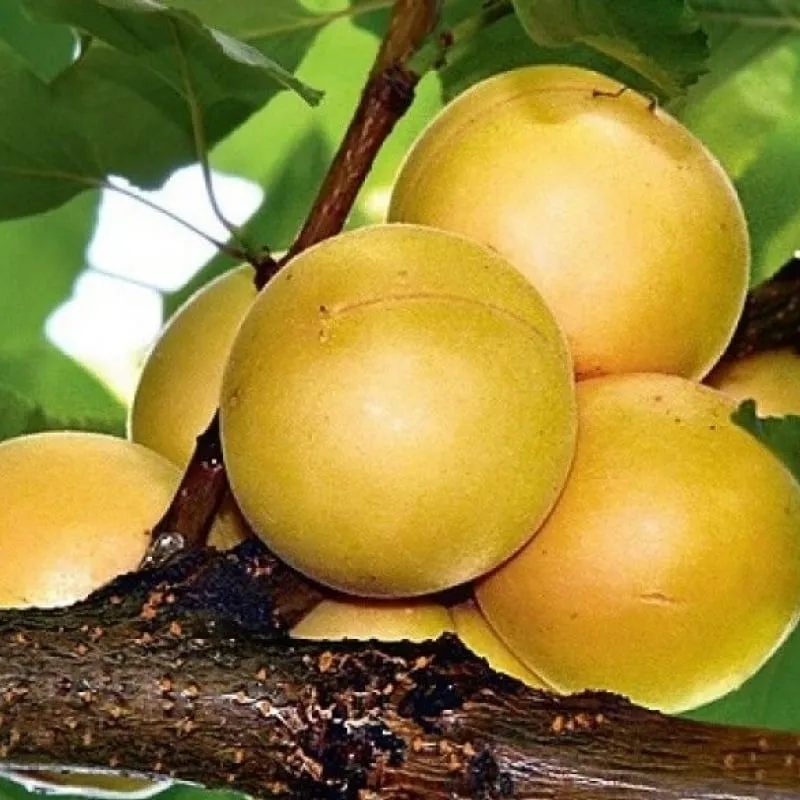
This mid-late variety is planted in temperate and Southern European climates. The fruits weigh 20 g, with firm, yellow-orange flesh. The skin has slight fuzz, and the flavour is balanced and mildly sweet. The heart-shaped pit separates easily. Edelweiss is drought-resistant and disease-tolerant.
Viking
Viking blooms in April–May, yielding its first harvest by June. The round fruits have smooth skin and a rich yellow hue, weighing about 20 g. The sweet, harmonious flavour has a pleasant fruity aroma. Viking is versatile — ideal for winter preserves.
White Apricots
True white apricots don’t exist, but some varieties have a creamy-orange hue, earning them the nickname. In taste and use, they are identical to classic yellow and orange apricots.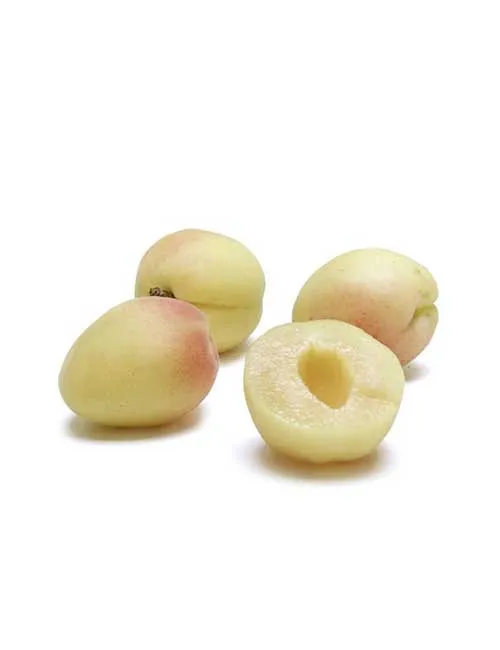
Peach Apricot
This mid-late variety ripens reliably and is low-maintenance. The oval-round fruits weigh about 50 g. The fuzzy skin is pale yellow, without blush. The tender, juicy flesh is sweet, separating easily from the small pit. At technical ripeness, these apricots are suitable for transport.
Albino
The pale yellow fruits delight with their unique appearance. The shape is flattened oval-round, weighing about 20 g. The medium-density, yellowish flesh has a pleasant taste. These apricots are great fresh or processed. After harvest, they store for up to 30 days without losing quality. Albino ripens in late July or early August.
Sirius
This mid-season apricot ripens by mid-July. The colour is pale orange with a blush. The fruits weigh up to 40 g, with a sweet-tart flavour. The tree is vigorous and spreading, with moderate disease resistance. Post-harvest storage lasts up to two weeks.
Seraphim
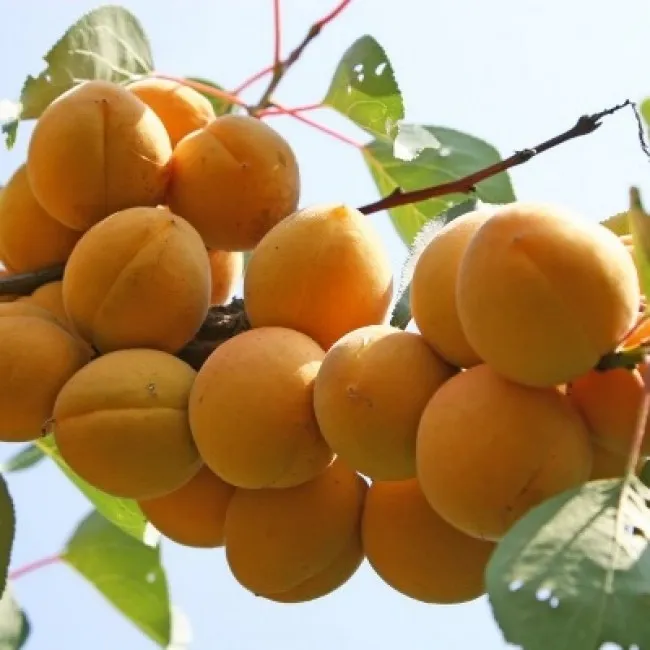
A mid-season variety, ripening in early July in Southern Europe. The creamy fruits have an orange-yellow blush on the sun-exposed side. The shape is flattened round. The velvety, fuzzy skin clings to the flesh. The tender, slightly mealy flesh is sweet, with a moderate aroma. Seraphim begins fruiting in its second to fourth year, yielding about 30 kg per tree.
Conclusion
Apricots vary in ripening times. Early varieties like Goldrich and Harostar produce fruit by early summer — perfect for fresh eating or preserves. Mid-season varieties ripen by mid-July. Gardeners favour Royal, Phelps, and Olympus for their large, juicy fruits. Late-season Favourite and Orlovchanin are ideal for storage and transport, retaining quality without cracking. Ripeness is determined by colour, firm skin, fuzz, and a sweet, fragrant aroma.







